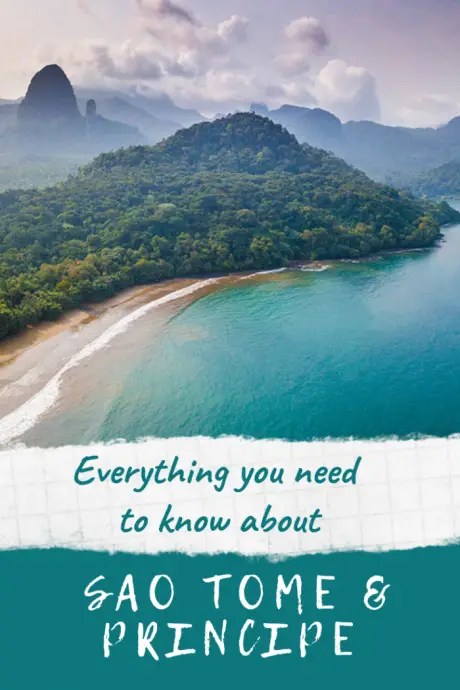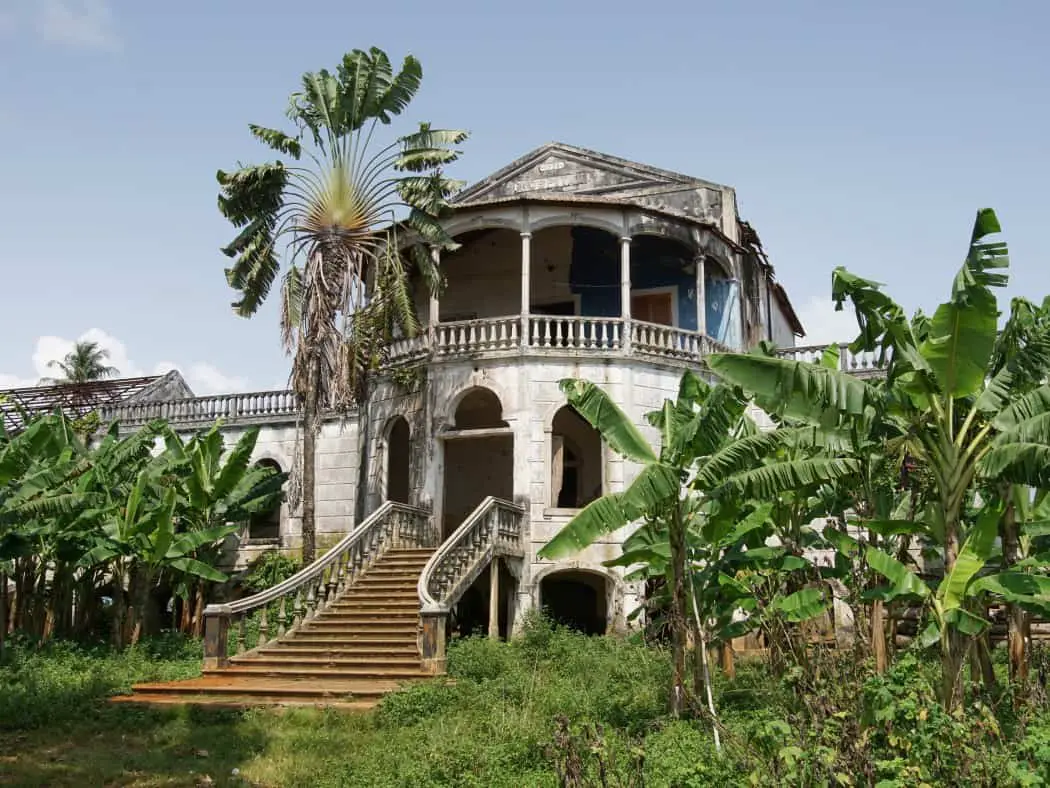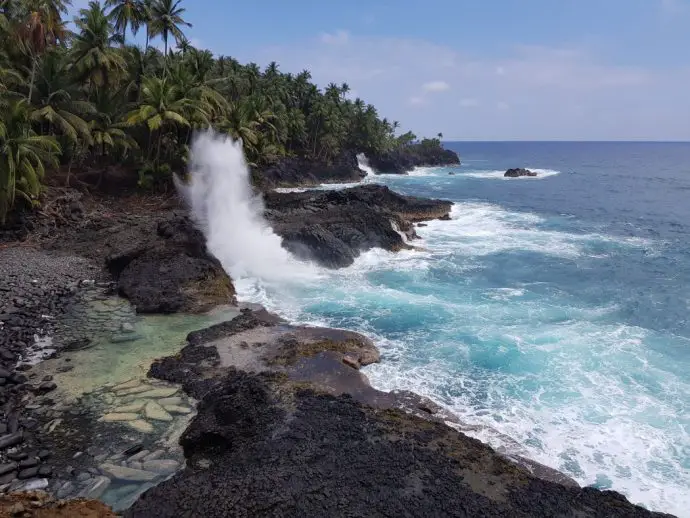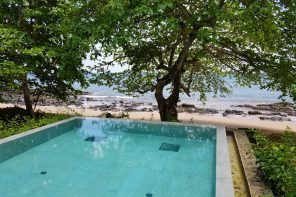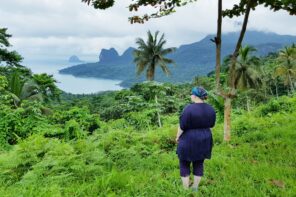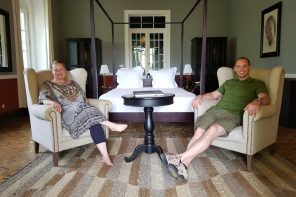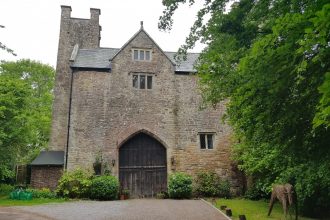We’re about to head off on a São Tomé and Príncipe holiday, an adventure to tropical islands off the coast of west Africa, visited by few and loved by all who travel here. There’s not a lot of information available about this remote island nation, so we’ve put together this guide to São Tomé and Príncipe to help you plan your own trip!
São Tomé and Príncipe
Where it all began
A couple of years ago I bought Her Ladyship the Lonely Planet ‘Guide to the World’ for Christmas (oh yes, I know how to spoil her!). We made a deal. I’d flick through the book, she would shout ‘stop’, and whichever page it landed on would be our next destination. The book opened on a place neither of us had even heard of, and just like that it was decided. São Tomé and Príncipe here we come!
Only we didn’t.
It was 2017, and the year of our 10th wedding anniversary. We’d always talked about going back to Peru where we had spent our honeymoon, and before we knew it, flights were booked. And always wanting to make the most of a trip, we somehow tagged on Colombia and the Caribbean island of Curaçao too. Then I stumbled upon a ‘too good to miss’ offer for a Kenya Safari, and we had a fantastic invitation to visit Sri Lanka so we squeezed them in as well. Our Sao Tome and Principe holiday was swept well and truly under the carpet.
But it wasn’t forgotten. There has always been a nagging feeling that wouldn’t go away until we’d followed through with our plan. We had made a deal to go, and should stick to that decision. So even though it is later than we had originally planned…
We’re off to visit São Tomé and Príncipe!
Just where is São Tomé and Príncipe?
If, like us when we opened that page, you’re kinda scratching your head, wondering ‘Sao who?’, here are a few quick-fire facts to put you in the picture:
- Sao Tome and Principe are two tiny tropical islands in the Gulf of Guinea, about 250km east of Gabon
- The islands are known as the ‘Centre of the World’ as this is where the Equator crosses the zero meridian line
- Population: around 195,000
- Language: Portuguese
- Sao Tome and Principle is the second-smallest country in Africa at around 1000 km2
- Time: GMT (handy for us Brits!)
- Currency: Dobra (Db), but Euros are widely accepted
- There are up to 30,000 visitors a year, so now is the time to go!
- 90% of the country is forested (40% is protected reserve)
Sao Tome and Principe has been hailed as one of the top places to visit in 2019 and we are super excited to be going somewhere that isn’t yet firmly on the tourist trail. São Tomé and Príncipe is yet to feature in many guidebooks, or even online, and this emerging tourist destination is often described as ‘undiscovered’.
It won’t stay that way for long, so now is the time to visit!
Read More: The Ultimate 10 Day Sao Tome and Principe Itinerary
The ‘Chocolate Islands’
‘Discovered’ by Portuguese explorers in the late 15th Century, these uninhabited islands were named after the feast day of Saint Thomas, and settlers were shipped in from Europe to colonise. In 1515 the Portuguese king gave the African slaves belonging to the colonists their freedom, and today much of the population is made up of mesticos, mixed-blood descendants of settlers and slaves, forros, descendants of freed slaves, and Europeans.
The islands became a large producer and exporter of sugarcane and coffee, as well as being an important transatlantic outpost for the slave trade (until 1869 when slavery was outlawed). Perhaps most famously however, São Tomé and Príncipe were known as the ‘Chocolate Islands’ thanks to the prevalence of cocoa plantations and the fine quality of chocolate produced here. Indeed it was some of the best in the world. Yet economic challenges during the 1980s -90s saw the collapse of the cocoa industry, and the few plantations that remain today are now privatised.
The islands remained a Portuguese colony until independence in 1975. Following independence, São Tomé and Príncipe turned to 15 years of Communism and closely aligned itself with Cuba, Angola and communist Eastern Europe. After the demise of The Soviet Union, São Toméans demanded a democratic multi-party approach to politics with the first elections being held in 1991.
Today São Tomé is the more developed of the two islands, whilst Príncipe remains remote and mysterious yet accessible. Most visitors begin their holiday with a couple of days on São Tomé before heading to Príncipe for a spot of jungle wilderness and beach hopping.
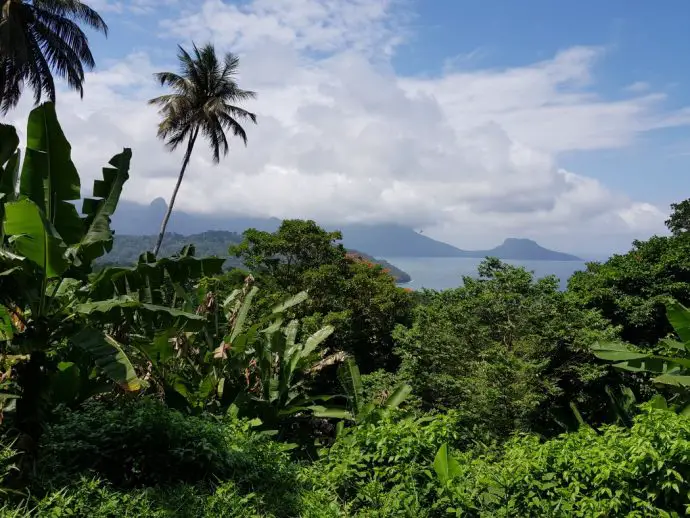
Geography and Wildlife
Príncipe is 31 million years old and São Tomé is half its age. Together they form part of a chain of volcanoes known as the Cameroon Line. The islands sit bang on the equator with a tropical climate, and both dry and wet seasons. When first discovered, the islands were swathed in primary rainforest and although most of this was cut down during colonisation, a secondary canopy now covers most of Príncipe, which was declared a UNESCO World Biosphere Reserve in 2013.
São Tomé is more developed, but its interior and most of the south are forested and in 2006 the Obô Natural Park was created. Despite São Tomé and Príncipe being remote, the country has the highest concentration of endemic bird species in the world, as well as over 700 plant species, many of which can’t be found anywhere else. Indeed, many scholars compare it to the Galapagos Islands. São Tomé and Príncipe is also home to introduced species like the African civet and black cobra, whilst out in the surrounding waters there are many endemic species of fish, and time of year depending, nesting sea turtles, dolphins and humpback whales.
How to get to São Tomé and Príncipe
It’s actually really easy to get to São Tomé and Príncipe, with the most popular route being with TAP Air Portugal via Lisbon (with a stop in Accra in Ghana to refuel).
To get from São Tomé to Príncipe it’s just a short flight with STP Airways (just be aware that there’s a 15kg baggage limit!).
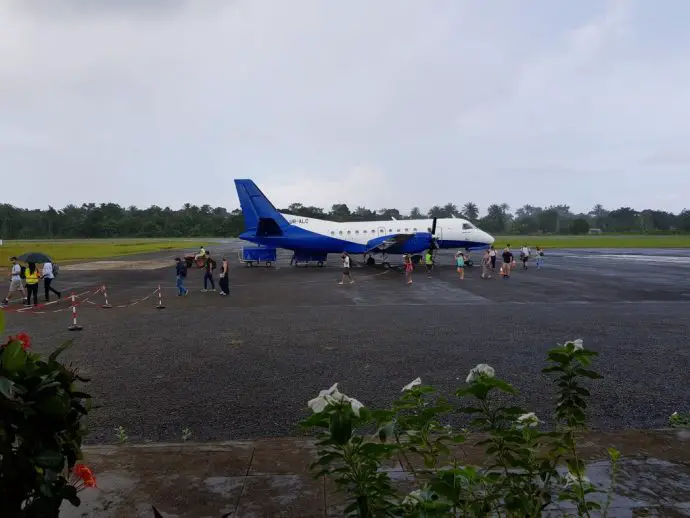
Best time to visit São Tomé and Príncipe
The weather in São Tomé and Príncipe is quite complex, but there isn’t really one best time to visit these tropical islands. Temperatures remain pretty constant throughout the year, at around 27°C to 29°C, but it’s the rainfall that you need to take into consideration. Príncipe has a wetter climate, with the south receiving the highest rainfall.
The dry seasons run between June and September, and December to April, whereas the rainy seasons are October – November, and March – May. But don’t get hung up on the rain. It doesn’t generally rain all day, and the showers tend to clear the air, leaving blue skies (which you won’t come across much during the cloudy dry seasons), which is good news for photographers.
The best way to decide when to visit São Tomé and Príncipe is according to what activities you want to do. If watching turtles hatching or whale watching are top of your list, go during the rainy season, but if hiking is your thing, it’s better to do this during the dry season.
We’re going in September, at the end of the dry season and the start of the wet, so fingers crossed we’ll experience the best of both worlds.
São Tomé and Príncipe Hotels
Most people spend their first couple of nights on São Tomé island, with one of the best accommodation options being Omali Lodge. It’s not far from the airport, and is ideally located for exploring the island.
There are a small handful of luxury Príncipe hotels and lodges, ranging from plantation houses to beach retreats. Bom Bom is the place to go if you’re looking for a castaway island experience. Wooden chalets are surrounded by palm-fringed beaches and rainforest, accessed by a rather fun wooden walkway over the sea. Then there’s Sundy Praia, an indulgent forest lodge just metres from the shore, with luxurious tented villas and a designer restaurant with cuisine to match. If you want to stay in a beautifully restored cocoa plantation house nestled in the jungle, there are two options – Roca Sundy and Roca Belo Monte, both of which are small boutique hotels with a fascinating history and tasteful decor.
Read More: Best Places To Stay In São Tomé and Príncipe
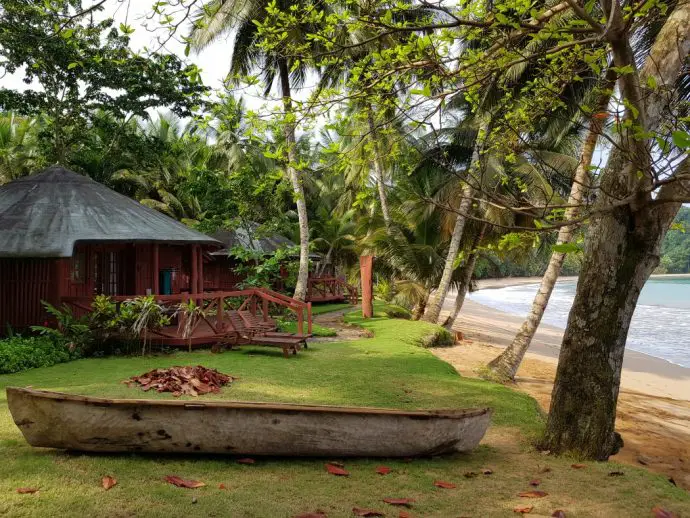
When you look at São Tomé and Príncipe on a map, you could be forgiven for thinking there wouldn’t be much to do on the islands. Yet despite its size, Africa’s second-smallest nation has a lot to offer. If you’re into your landscapes, beaches, nature, stunning accommodation, and relaxed, friendly people then you can’t go too wrong with a trip to São Tomé and Príncipe.
Best Things to Do In São Tomé and Príncipe:
Beach Hopping
The beaches on São Tomé and Príncipe are stunning, and perhaps most importantly, there is usually hardly anyone else around! You may stumble across a local fisherman, but you won’t feel the need to be up at the crack of dawn to claim a sun lounger.
One of the best things to do on São Tomé and Príncipe is beach hopping by boat, stopping for snorkelling and picnics along the way. You might recognise Banana Beach on Príncipe from the famous Bacardi advert back in the 1990s. It’s one of the the most iconic and photogenic!
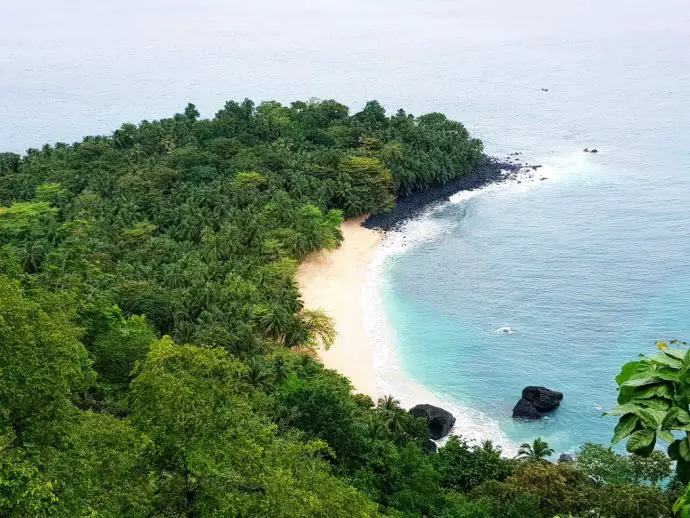
Read More: 35 Ultimate Things to do on São Tomé and Príncipe
Baia das Agulhas (Bay of spires)
A boat trip is a must to really appreciate the spire-like phonolite towers that dwarf the surrounding area of Principe. As you bob along, you can’t help but feel like you’re being transported back to pre-historic times.
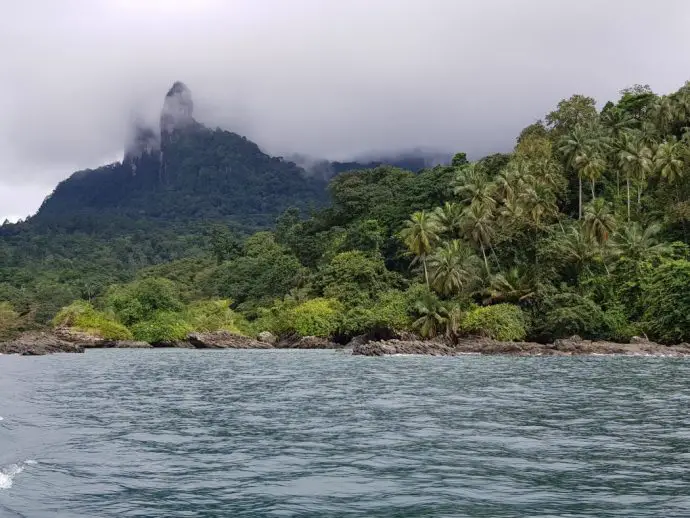
Plantation Houses
Explore São Tomé and Príncipe’s colonial past and visit one of 800 plantations that are scattered across islands. Some are still in agricultural use (although on a smaller scale) like Roca São Joao, whilst others have been converted into hotels and cafes. You may prefer to visit those that have long been forgotten by everything but nature, which is slowly reclaiming the land. Água Izé, Monté Café, and Roça Abade are just three of many fantastic places. Some plantations have been restored and transformed into boutique guest houses, like at Roca Sundy on São Príncipe.
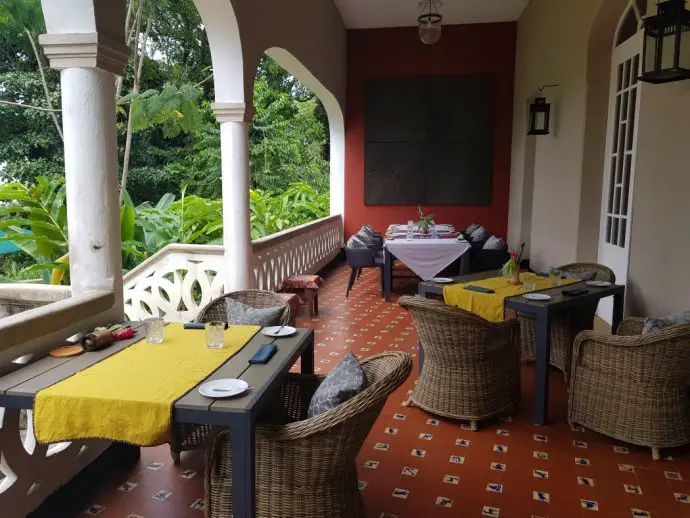
Read More: Things They Don’t Tell You About São Tomé and Príncipe
Watersports
Snorkelling and scuba diving can be done from the beaches. or from organised boat trips visiting reefs and shipwrecks. Regardless of the location, because of average sea temperatures and the excellent visibility, you’re almost sure to see some fantastic sea life, which could include octopus, turtles, nurse sharks and whale sharks (depending on where you are diving from!).
For those who prefer to be on the water rather than in it, then you can charter a yacht for short trips to remote beaches, or for if you want longer out on the water, try an adventurous circumnavigation of São Tomé.
Wildlife Watching
Depending on when you visit, you may get to see turtles coming up onto the beaches to lay their eggs or the baby turtles hatching and making a dash for the safety of the sea. São Tomé and Príncipe is home to Olive Ridley, Green, Leatherback and Hawksbill turtles, all four species being listed as endangered.
Whale watching in São Tomé and Príncipe is on the cards between July and October, when humpback whales migrate along the north eastern shores of the islands. To see this incredible spectacle, head out on a boat trip either early in the morning or during the late afternoon.
If bird watching is your thing, then you’ll be keen to know that São Tomé and Príncipe has at least 26 endemic bird species to discover, and sightings can be as easy as from your balcony. Or take a specialist bird watching tour, some of which include jungle walking and canoeing through mangrove swamps.
Obô Natural Park
Approximately 30 minutes from the town of São Tomé, Obô Natural Park is an adventurer’s delight whether you want to walk one of the marked trails or hire a guide and disappear with food and camping gear for a couple of days. And with the park covering about 60% of the islands territory it is highly unlikely that you’ll be tripping over anyone else.
Obô Natural Park is also home to “Pico de São Tomé” a 2024m peak soaring over the surrounding jungles. For some, seeing it from the road is enough, but if you want, you can take a two day camping trip up to the summit. Then there’s Pico Cao Grande (Great Dog Peak), a looming spire of magma left behind after a volcanic eruption, an iconic sight seen from many parts of São Tomé.
Regardless of your reasons for going into the park, you are sure to walk by any number of the 700 native plants (of which 100 are orchids unique to the island), and be serenaded by some of the 143 bird species.
São Tomé Town
Make sure you spend some time in the capital of the island, which was founded in 1485 by the Portuguese and granted city status by the king in 1535. With Portuguese colonial architecture, cathedral, Presidential Palace and a 16th century fort just for starters, you can easily spend a day exploring here.
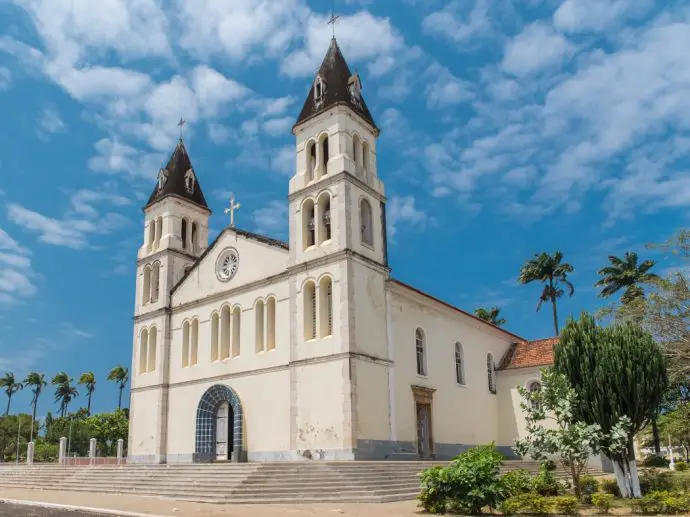
Príncipe Island Tour
The smaller island of Príncipe is designated a UNESCO Biosphere Reserve, and there are several day tours taking in different aspects of the land. 4×4 excursions will visit villages, plantations and beaches to give you a real flavour of Príncipe, as well as taking in Santo António, the smallest capital city in the world, and discovering the secrets of cocoa. Despite its small size, Príncipe is also significant in the international world of science. If you visit the Roço Sundy Cocoa Plantation you’ll see the spot where Sir Arthur Stanley Eddington (a British astrophysicist) was the first to prove Einstein’s Theory of Relativity, back in 1919 (100 years ago)!
We’ll be reporting back on our adventures after our trip in September, so watch this space!
UPDATE: We’re just back! And it was amazing. You can read all our posts about São Tomé and Príncipe HERE.
Have you been to São Tomé and Príncipe? Do you have any tips?
[separator type=”thin”]
Found this post useful? Why not pin it for later…
